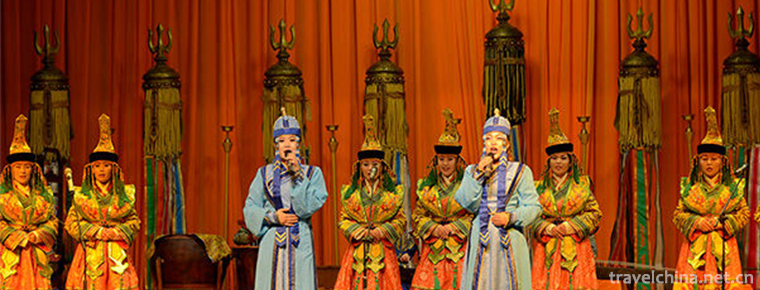Mongolian Khantin Music
Mongolian Khantin Music
The most important component of Mongolian traditional music is court music, which is Mongolian Khan music. Successfully selected into the fourth batch of national intangible cultural heritage list.
introduce
The capital of Lindan Khan, the last generation of Mongolian Khan, is the ancient city of Chaganhot in Arukhorqin Banner. It is recognized as an important base for studying Mongolian Khantin music by academic circles at home and abroad. According to historical records and detailed research and full demonstration by experts and scholars in academic circles, Lindan Khan Court Music, which prevailed in the Mongol and Yuan Dynasties, is a relatively complete Mongolian Khan Court Music material known at present. More than 300 years ago, Mongolian Khantin music flowed into the court of the Qing Dynasty. More than 300 years later, a text recording Mongolian Khantin music was found here again. The Mongolian Khantin band was founded in the first year of Taizu and prevailed in the Yuan Dynasty. It was a band specially performed in front of the Mongolian Golden Curtain Hall for Khan's succession, kings or foreign dynasties, empresses, princes and ministers. Honorable title, as well as suburban temple Richeng, ministers congratulations, Da Duan clan and relatives and other scenes. The music of Mongolian Khantin music is magnificent and magnificent. The music includes Khan eulogy, court praise, religious etiquette, folk proverbs and philosophical instructions. It consists of three parts: music, music and dance. It has more than 80 repertoires. A total of 18 instruments are needed, such as Hu Jian, Hu Qin, Sanxian, Mongolian Zheng and Hu Busi.
By the end of the Northern Yuan Dynasty, Khan Lindan Khan showed a new atmosphere in court music and dance. The Northern Yuan Dynasty perished, but Lindan Khan's court music was favored by Emperor Tai Chi of the Qing Dynasty, and continued to be used in the Qing Palace. Mongolian court music was introduced into the Qing Palace and became an important part of the Qing Palace music.
Recent developments
The people's government of Arukherqin Banner attaches great importance to the protection and excavation of "Mongolian Court Music" and lists it as a banner-level intangible cultural heritage. Under the chairmanship of Professor Hugeletu of Inner Mongolia Normal University, in 2009, the people's government of Arukherqin Banner started the excavation, rescue and restoration of Mongolian Lindanhan Court Music and established the Mongolian Khantin Band. After careful planning and rehearsal, a series of works have been completed, such as the reproduction of musical instruments, the arrangement of musical scores, the design of costumes, the rehearsal of bands, the choreography of dances, the setting of stage and the selection of actors. The Mongolian Khantin music, which was lost for a long time, was restored. The Mongolian Khantin band, which was founded in the first year of Taizu Yuan, is now reappearing on the North Horqin grassland.
On November 11, 2014, the State Council issued the fourth batch of representative projects of national intangible cultural heritage, and Mongolian Hanting music was successfully selected. Classified as traditional music.


-
1.Huizhou West Lake Scenic Spot
Huizhou West Lake scenic area is located in the central area of Huicheng in Guangdong Province, Southeast of Huizhou City, consisting of West Lake and the Red Lake, a total area of 20.91 square kilome
Time 2018-12-12 -
2.JiuMenKou Great WallTime 2018-12-22
-
3.Nanshan Bamboo Sea Scenic Area
Tianmu Hunan Shanzhuhai Scenic Area is located in Liyang, Jiangsu Province, which is the junction of Jiangsu and Anhui Provinces. It is a national 5A scenic spot.
Time 2018-12-31 -
4.Putuo Zong Cheng
Putuo Zongcheng Temple, located in the north of Chengde Summer Resort and south of Shizigou, Hebei Province, covers an area of 220,000 square meters
Time 2019-02-07 -
5.Sharipol wrestling
Shaliboer style wrestling is a national traditional sports event originally created and retained by the Weilat Mongolian people. It is one of the main sports events in the Uznada Mu Grand Event in Ala
Time 2019-06-12 -
6.Traditional Brewing Techniques of Distilled Liquor
Distilled liquor brewing is to first make grains, potatoes and other starch-rich or sugar-rich raw materials into grains (no filtered wine) or fermentation into grains (turbid wine), and then distille
Time 2019-07-25 -
7.University Of Science and Technology Beijing
Beijing University of Science and Technology was established in 1952 by the Department of Mining and Metallurgy of 6 famous universities in China, such as Tianjin University (formerly Beiyang Universi
Time 2019-09-06 -
8.Peking Union Medical College
The Chinese Academy of Medical Sciences was established in 1956. Peking Union Medical College was founded in 1917. Since 1957, the Chinese Academy of Medical Sciences and Peking Union Medical College
Time 2019-09-06 -
9.Hydrological survey of Mianyang
Affected by the landform, Mianyang has abundant precipitation, large runoff, vertical and horizontal rivers and developed water system. There are more than 3000 rivers and gullies in the city. All rivers and gullies flow into Fujiang, Bailongjiang and Xihe
Time 2020-12-14 -
10.Geographical environment of Suining
Suining City is located in the middle of Sichuan Basin and the middle reaches of Fujiang River. It is between 105 ° 03 ′ 26 ″ - 106 ° 59 ′ 49 ″ E and 30 ° 10 ′ 50 ″ - 31 ° 10 ′ 50 ″ n.
Time 2020-12-16 -
11.Nanchong hydrology
Nanchong is rich in precipitation. The average annual precipitation is 1000 mm, excluding evaporation, the annual total water is about 4.191 billion cubic meters, and the average annual runoff depth is about 313 mm. The distribution of runoff depth is generally
Time 2020-12-17